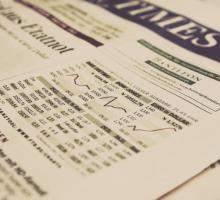The real exchange rate measures the price of foreign goods relative to the price of domestic goods.
Mathematically, the real exchange rate is the ratio of a foreign price level and the domestic price level, multiplied by the nominal exchange rate.
Formally:
R = (E.P*)/P
Where:
R: real exchange rate
E: nominal exchange rate
P*: foreign price level
P: domestic price level
While the nominal exchange rate measures the relation between the value of two currencies The real exchange rate measures the relative price of goods.
Price of a basket of Foreign Goods, expressed in local currency: E.P*
Price of a basket of Local Goods, expressed in local currency: P
Measuring the Real Exchange Rate
Price Index
A price index compares the prices of goods in a period of time, in relation to another period of time, usually called the base period. If we choose another base period, the price index will also change. This is why, the absolute value of the real exchange rate has no meaning if we do not compare it's value with the value of the real exchange rate in another period of time.
There are several price indexes that can be taken for the calculation of the real exchange rate: the consumer price index, the GDP deflator, the tradable goods price index, etc. Each price index has a different basket of goods.
Countries: Bilateral Real Exchange Rate or Real Effective Exchange Rate
For the foreign price index, we have to choose what country will be included in the calculation of the real exchange rate. The real exchange rate can be calculated between only two countries (bilateral real exchange rate), but we can also take multiple countries into account (multilateral real exchange rate). There is no single "right" way to measure the real exchange rate. Economists usually choose the countries that will be taken into account, based on the purpose of the analysis they are carrying over.
Real Effective Exchange Rate (REER)
The Real Effective Exchange Rate (REER) takes multiple countries into account. Usually, it weights each country by the relative trade with the country for which we are calculating the real exchange rate.
The International Monetary Fund uses a weighted average of several foreign currencies, divided by a price deflator or index of costs.
Real Exchange Rate vs Nominal Exchange Rate
The nominal bilateral exchange rate (NBER) doesn't take prices levels into consideration. It's the price of a currency expressed in terms of another currency. The nominal effective exchange rate (NEER) uses a weighted average of indexed nominal bilateral rates. To measure competitiveness, the NEER is better than the NBER, but the real exchange rate (RER) and the real effective exchange rate are better options to measure real competitiveness, since the real exchange rate takes also prices of goods into consideration.
Fluctuations in the Real Exchange Rate
The real exchange rate can vary if there are changes in:
- E: the nominal exchange rate
- P*: the foreign price index
- P: the local price index
If the real exchange rate rises, it means that we need more local goods to purchase the same amount of foreign goods: foreign goods have become more expensive in term of local goods. Ceteris Paribus, this can good for local producers, since imported goods have become more expensive and maybe local consumers will be choosing local goods instead of foreign imported goods, in some cases. Also, this can boost exports, since foreign consumers can replace foreign produced goods with locally produced goods.
Competitiveness is the capability a country has, to achieve profitability in the international market in relation to its competitors. The real exchange rate is an important factor in competitiveness. An appreciated exchange rate may favor production of nontradable goods and imports.




